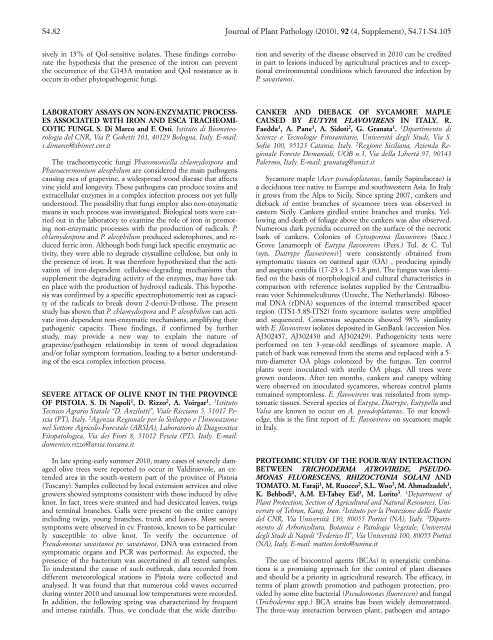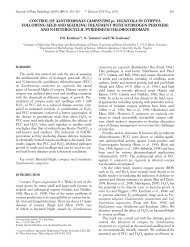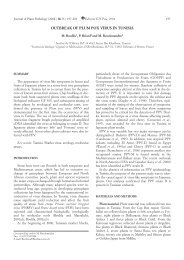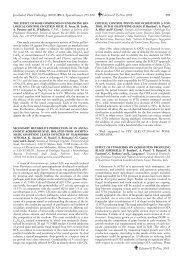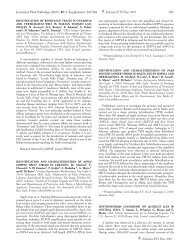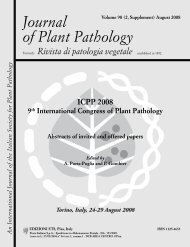Journal of Plant Pathology (2010), 92 (4, Supplement ... - Sipav.org
Journal of Plant Pathology (2010), 92 (4, Supplement ... - Sipav.org
Journal of Plant Pathology (2010), 92 (4, Supplement ... - Sipav.org
Create successful ePaper yourself
Turn your PDF publications into a flip-book with our unique Google optimized e-Paper software.
S4.82 <strong>Journal</strong> <strong>of</strong> <strong>Plant</strong> <strong>Pathology</strong> (<strong>2010</strong>), <strong>92</strong> (4, <strong>Supplement</strong>), S4.71-S4.105<br />
sively in 15% <strong>of</strong> QoI-sensitive isolates. These findings corroborate<br />
the hypothesis that the presence <strong>of</strong> the intron can prevent<br />
the occurrence <strong>of</strong> the G143A mutation and QoI resistance as it<br />
occurs in other phytopathogenic fungi.<br />
LABORATORY ASSAYS ON NON-ENZYMATIC PROCESS-<br />
ES ASSOCIATED WITH IRON AND ESCA TRACHEOMI-<br />
COTIC FUNGI. S. Di Marco and F. Osti. Istituto di Biometeorologia<br />
del CNR, Via P. Gobetti 101, 40129 Bologna, Italy. E-mail:<br />
s.dimarco@ibimet.cnr.it<br />
The tracheomycotic fungi Phaeomoniella chlamydospora and<br />
Phaeoacremonium aleophilum are considered the main pathogens<br />
causing esca <strong>of</strong> grapevine, a widespread wood disease that affects<br />
vine yield and longevity. These pathogens can produce toxins and<br />
extracellular enzymes in a complex infection process not yet fully<br />
understood. The possibility that fungi employ also non-enzymatic<br />
means in such process was investigated. Biological tests were carried<br />
out in the laboratory to examine the role <strong>of</strong> iron in promoting<br />
non-enzymatic processes with the production <strong>of</strong> radicals. P.<br />
chlamydospora and P. aleophilum produced siderophores, and reduced<br />
ferric iron. Although both fungi lack specific enzymatic activity,<br />
they were able to degrade crystalline cellulose, but only in<br />
the presence <strong>of</strong> iron. It was therefore hypothesized that the activation<br />
<strong>of</strong> iron-dependent cellulose-degrading mechanisms that<br />
supplement the degrading activity <strong>of</strong> the enzymes, may have taken<br />
place with the production <strong>of</strong> hydroxyl radicals. This hypothesis<br />
was confirmed by a specific spectrophotometric test as capacity<br />
<strong>of</strong> the radicals to break down 2-deoxi-D-ribose. The present<br />
study has shown that P. chlamydospora and P. aleophilum can activate<br />
iron-dependent non-enzymatic mechanisms, amplifying their<br />
pathogenic capacity. These findings, if confirmed by further<br />
study, may provide a new way to explain the nature <strong>of</strong><br />
grapevine/pathogen relationship in term <strong>of</strong> wood degradation<br />
and/or foliar symptom formation, leading to a better understanding<br />
<strong>of</strong> the esca complex infection process.<br />
SEVERE ATTACK OF OLIVE KNOT IN THE PROVINCE<br />
OF PISTOIA. S. Di Napoli 1 , D. Rizzo 2 , A. Voirgar 1 . 1 Istituto<br />
Tecnico Agrario Statale “D. Anzilotti”, Viale Ricciano 5, 51017 Pescia<br />
(PT), Italy. 2 Agenzia Regionale per lo Sviluppo e l’Innovazione<br />
nel Settore Agricolo-Forestale (ARSIA), Laboratorio di Diagnostica<br />
Fitopatologica, Via dei Fiori 8, 51012 Pescia (PT), Italy. E-mail:<br />
domenico.rizzo@arsia.toscana.it<br />
In late spring-early summer <strong>2010</strong>, many cases <strong>of</strong> severely damaged<br />
olive trees were reported to occur in Valdinievole, an extended<br />
area in the south-western part <strong>of</strong> the province <strong>of</strong> Pistoia<br />
(Tuscany). Samples collected by local extension services and olive<br />
growers showed symptoms consistent with those induced by olive<br />
knot. In fact, trees were stunted and had desiccated leaves, twigs<br />
and terminal branches. Galls were present on the entire canopy<br />
including twigs, young branches, trunk and leaves. Most severe<br />
symptoms were observed in cv. Frantoio, known to be particularly<br />
susceptible to olive knot. To verify the occurrence <strong>of</strong><br />
Pseudomonas savastanoi pv. savastanoi, DNA was extracted from<br />
symptomatic <strong>org</strong>ans and PCR was performed. As expected, the<br />
presence <strong>of</strong> the bacterium was ascertained in all tested samples.<br />
To understand the cause <strong>of</strong> such outbreak, data recorded from<br />
different meteorological stations in Pistoia were collected and<br />
analysed. It was found that that numerous cold waves occurred<br />
during winter <strong>2010</strong> and unusual low temperatures were recorded.<br />
In addition, the following spring was characterized by frequent<br />
and intense rainfalls. Thus, we conclude that the wide distribu-<br />
tion and severity <strong>of</strong> the disease observed in <strong>2010</strong> can be credited<br />
in part to lesions induced by agricultural practices and to exceptional<br />
environmental conditions which favoured the infection by<br />
P. savastanoi.<br />
CANKER AND DIEBACK OF SYCAMORE MAPLE<br />
CAUSED BY EUTYPA FLAVOVIRENS IN ITALY. R.<br />
Faedda 1 , A. Pane 1 , A. Sidoti 2 , G. Granata 1 . 1 Dipartimento di<br />
Scienze e Tecnologie Fitosanitarie, Università degli Studi, Via S.<br />
S<strong>of</strong>ia 100, 95123 Catania, Italy. 2 Regione Siciliana, Azienda Regionale<br />
Foreste Demaniali, UOB n.3, Via della Libertà 97, 90143<br />
Palermo, Italy. E-mail: granatag@unict.it<br />
Sycamore maple (Acer pseudoplatanus, family Sapindaceae) is<br />
a deciduous tree native to Europe and southwestern Asia. In Italy<br />
it grows from the Alps to Sicily. Since spring 2007, cankers and<br />
dieback <strong>of</strong> entire branches <strong>of</strong> sycamore trees was observed in<br />
eastern Sicily. Cankers girdled entire branches and trunks. Yellowing<br />
and death <strong>of</strong> foliage above the cankers was also observed.<br />
Numerous dark pycnidia occurred on the surface <strong>of</strong> the necrotic<br />
bark <strong>of</strong> cankers. Colonies <strong>of</strong> Cytosporina flavovirens (Sacc.)<br />
Grove [anamorph <strong>of</strong> Eutypa flavovirens (Pers.) Tul. & C. Tul<br />
(syn. Diatrype flavovirens)] were consistently obtained from<br />
symptomatic tissues on oatmeal agar (OA) , producing spindly<br />
and aseptate conidia (17-23 x 1.5-1.8 µm). The fungus was identified<br />
on the basis <strong>of</strong> morphological and cultural characteristics in<br />
comparison with reference isolates supplied by the Centraalbureau<br />
voor Schimmelcultures (Utrecht, The Netherlands). Ribosomal<br />
DNA (rDNA) sequences <strong>of</strong> the internal transcribed spacer<br />
region (ITS1-5.8S-ITS2) from sycamore isolates were amplified<br />
and sequenced. Consensus sequences showed 98% similarity<br />
with E. flavovirens isolates deposited in GenBank (accession Nos.<br />
AJ302457, AJ302430 and AJ302429). Pathogenicity tests were<br />
performed on ten 3-year-old seedlings <strong>of</strong> sycamore maple. A<br />
patch <strong>of</strong> bark was removed from the stems and replaced with a 5mm-diameter<br />
OA plugs colonized by the fungus. Ten control<br />
plants were inoculated with sterile OA plugs. All trees were<br />
grown outdoors. After ten months, cankers and canopy wilting<br />
were observed on inoculated sycamores, whereas control plants<br />
remained symptomless. E. flavovirens was reisolated from symptomatic<br />
tissues. Several species <strong>of</strong> Eutypa, Diatrype, Eutypella and<br />
Valsa are known to occur on A. pseudoplatanus. To our knowledge,<br />
this is the first report <strong>of</strong> E. flavovirens on sycamore maple<br />
in Italy.<br />
PROTEOMIC STUDY OF THE FOUR-WAY INTERACTION<br />
BETWEEN TRICHODERMA ATROVIRIDE, PSEUDO-<br />
MONAS FLUORESCENS, RHIZOCTONIA SOLANI AND<br />
TOMATO. M. Faraji 1 , M. Ruocco 2 , S.L. Woo 3 , M. Ahmadzadeh 1 ,<br />
K. Behbodi 1 , A.M. El-Tabey Eid 3 , M. Lorito 3 . 1 Department <strong>of</strong><br />
<strong>Plant</strong> Protection, Section <strong>of</strong> Agricultural and Natural Resources, University<br />
<strong>of</strong> Tehran, Karaj, Iran. 2 Istituto per la Protezione delle Piante<br />
del CNR, Via Università 130, 80055 Portici (NA), Italy. 3 Dipartimento<br />
di Arboricoltura, Botanica e Patologia Vegetale, Università<br />
degli Studi di Napoli “Federico II”, Via Università 100, 80055 Portici<br />
(NA), Italy. E-mail: matteo.lorito@unina.it<br />
The use <strong>of</strong> biocontrol agents (BCAs) in synergistic combinations<br />
is a promising approach for the control <strong>of</strong> plant diseases<br />
and should be a priority in agricultural research. The efficacy, in<br />
terms <strong>of</strong> plant growth promotion and pathogen protection, provided<br />
by some elite bacterial (Pseudomonas fluorescen) and fungal<br />
(Trichoderma spp.) BCA strains has been widely demonstrated.<br />
The three-way interaction between plant, pathogen and antago-


